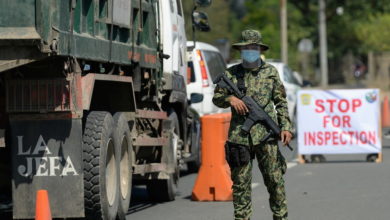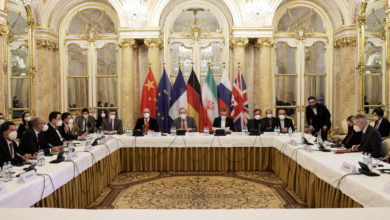Ukraine’s Nuclear Plant Partly Goes Offline Amid Fighting

ZAPORIZHZHIA, Ukraine — The head of the U.N. nuclear watchdog said Saturday that the Russian-controlled Zaporizhzhia nuclear plant in Ukraine was disconnected to its last external power line but was still able to run electricity through a reserve line amid sustained shelling in the area.
International Atomic Energy Agency Director-General Rafael Grossi said in a statement that the agency’s experts, who arrived at Zaporizhzhia on Thursday, were told by senior Ukrainian staff that the fourth and last operational line was down. The conflict had already claimed the three other lines.
However, IAEA experts discovered that the reserve link between the facility and nearby thermal power plants was providing electricity for the external grid. This reserve line is also able to provide back-up power for the plant, if necessary.
“We already have a better understanding of the functionality of the reserve power line in connecting the facility to the grid,” Grossi said. “This is crucial information in assessing the overall situation there.”
In addition, the plant’s management informed the IAEA that one reactor was disconnected Saturday afternoon because of grid restrictions. The statement stated that another reactor continues to operate and produce electricity, both for cooling, safety and the power supply for homes, factories, and other sites.
The Zaporizhzhia facility, which is Europe’s largest nuclear plant, has been held by Russian forces since early March, but its Ukrainian staff are continuing to operate it.
Russian-appointed Enerhodar municipal administration blamed a alleged Ukrainian bombardment on Saturday for the destruction of a vital power line.
“The provision of electricity to the territories controlled by Ukraine has been suspended due to technical difficulties,” the municipal administration said in a post on its official Telegram channel. It wasn’t clear whether electricity from the plant was still reaching Russian-held areas.
Vladimir Rogov, an official of the Kremlin’s regional administration claimed that a bomb had been dropped in an area near two reactors. His claims couldn’t be immediately verified.
In the last few weeks Russia and Ukraine have been blaming one another for shelling near and at the plant. They also accused each other of trying to impede the IAEA expert visit, which is supposed to protect the site. Grossi said their presence at the site is “a game changer.”
Russia’s Defense Ministry said that Ukrainian troops launched another attempt to seize the plant late Friday, despite the presence of the IAEA monitors, sending 42 boats with 250 special forces personnel and foreign “mercenaries” to attempt a landing on the bank of the nearby Kakhovka reservoir.
According to the ministry, four Russian fighter planes and two helicopter gunships had destroyed approximately 20 boats while others were turned around. The ministry stated that Russian artillery also struck the Ukrainian-controlled right bank Dnieper River in an attempt to strike the retreating landing party.
The ministry claimed that the Russian military killed 47 troops, including 10 “mercenaries” and wounded 23. The Russian claims couldn’t be independently verified.
The plant has repeatedly suffered complete disconnection from Ukraine’s power grid since last week, with the country’s nuclear energy operator Enerhoatom blaming mortar shelling and fires near the site.
Moscow was accused by local Ukrainian authorities of attacking two towns that are located across the Dnieper River with rockets. This accusation has been repeated several times in the last weeks.
Residents of Zorya in central Russia could hear blasts from Zaporizhzhia’s plant 20km (12 miles) distant.
It’s not the shelling that scared them the most, but the risk of a radioactive leak in the plant.
“The power plant, yes, this is the scariest,” said Natalia Stokoz, a mother of three. “Because the kids and adults will be affected, and it’s scary if the nuclear power plant is blown up.”
Oleksandr Pasko, a 31-year-old farmer, said “there is anxiety because we are quite close.” Pasko said that the Russian shelling has intensified in recent weeks.
Authorities gave masks and tablets of iodine to radiation-exposed residents of nearby areas during the early weeks of the conflict.
Recently, they’ve also distributed iodine pills in Zaporizhzhia city, about 50 kilometers (31 miles) from the plant.
Turkish President Recep Tayyip Erdogan offered to take the role of “facilitator” on the issue of the Zaporizhzhia plant, in a phone call with Russian President Vladimir Putin on Saturday, according to a statement from the Turkish presidency.
The Ukrainian military on Saturday morning reported that Russian forces overnight pressed their stalled advance in the country’s industrial east, while also trying to hold on to areas captured in Ukraine’s northeast and south, including in the Kherson region cited as the target of Kyiv’s recent counteroffensive.
It added that Ukrainian forces repelled around a half-dozen Russian attacks across the Donetsk region, including near two cities singled out as key targets of Moscow’s grinding effort to capture the rest of the province. The Donetsk region is one of two that make up Ukraine’s industrial heartland of the Donbas, alongside Luhansk, which was overrun by Russian troops in early July.
Separately, the British military confirmed in its regular update Saturday morning that Ukrainian forces were conducting “renewed offensive operations” in the south of Ukraine, advancing along a broad front west of the Dnieper and focusing on three axes within the Russian-occupied Kherson region.
“The operation has limited immediate objectives, but Ukraine’s forces have likely achieved a degree of tactical surprise; exploiting poor logistics, administration and leadership in the Russian armed forces,” the U.K. defense ministry tweeted.
Officials in Ukraine said that a Russian bombardment had killed an eight-year old child and injured at least four other children. The attack was carried out in southern Ukrainian towns near the Kherson region.
Here are more must-read stories from TIME




